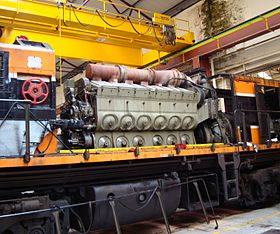EMD 645F3B
| EMD 645 | |
|---|---|

An EMD 12-645E3 turbocharged engine, installed in an Iarnród Eireann 071 class locomotive
|
|
| Overview | |
| Manufacturer | Electro-Motive Division of General Motors |
| Also called | E-Engine and F-Engine |
| Production | 1965–1983; limited runs through the 1990s |
| Combustion chamber | |
| Configuration | 45° Vee in V6, V8, V12, V16, or V20 |
| Displacement | 5,160 to 12,900 cu in (84.6 to 211.4 L) 645 cu in (10.6 L) per cylinder |
| Cylinder bore | 9 1⁄16 in (230 mm) |
| Piston stroke | 10 in (250 mm) |
| Cylinder block alloy | flat, formed and rolled structural steel members, and steel forgings, integrated into a weldment |
| Cylinder head alloy | cast iron, one per cylinder |
| Valvetrain | Intake ports in each cylinder liner, 4 exhaust valves in each cylinder head |
| Compression ratio | 14.5:1 |
| RPM range | |
| Idle | 200 |
| Redline | 950 |
| Combustion | |
| Supercharger | One or two Roots-type blower |
| Turbocharger | Single, clutch driven |
| Fuel system | Unit Injector |
| Management | Mechanical (Woodward governor) |
| Fuel type | Diesel |
| Oil system | Forced lubrication system, Wet sump |
| Cooling system | Liquid cooled |
| Output | |
| Power output | 750 to 4,200 hp (560 to 3,130 kW) |
| Chronology | |
| Predecessor | EMD 567 |
| Successor | EMD 710 |
The EMD 645 family of diesel engines was designed and manufactured by the Electro-Motive Division of General Motors. While the 645 series was intended primarily for locomotive, marine and stationary engine use, one 16-cylinder version powered the 33-19 "Titan" prototype haul truck designed by GM's Terex division.
The 645 series was an evolution of the earlier 567 series and a precursor to the later 710 series. First introduced in 1965, the EMD 645 series remained in production on a by-request basis long after it was replaced by the 710, and most 645 service parts are still in production. The EMD 645 engine series is currently supported by Electro-Motive Diesel, Inc., which purchased the assets of the Electro-Motive Division from General Motors in 2005.
In 1951, E. W. Kettering wrote a paper for the ASME entitled, History and Development of the 567 Series General Motors Locomotive Engine, which goes into great detail about the technical obstacles that were encountered during the development of the 567 engine. These same considerations apply to the 645 and 710, as these engines were a logical extension of the 567C, by applying a cylinder bore increase, 645, and a cylinder bore increase and a stroke increase, 710, to achieve a greater power output, without changing the external size of the engines, or their weight, thereby achieving significant improvements in horsepower per unit volume and horsepower per unit weight.
The 645 series engines entered production in 1965. As the 567 series had reached its limits in horsepower increases, a larger displacement was needed; this was accomplished by increasing the bore from 8 1⁄2 in (216 mm) on the 567 series to 9 1⁄16 in (230 mm) on the 645 series, while maintaining the same stroke and deck height. While the crankcase was modified from the 567 series, 567C and later engines (or 567 engines which have been modified to 567C specifications, sometimes referred to as 567AC or 567BC engines) can accept 645 series service parts, such as power assemblies. Conversely, the 567E engine employs a 645E series block with 567 series power assemblies.
...
Wikipedia
